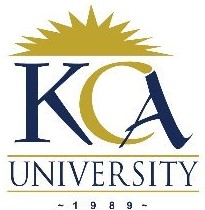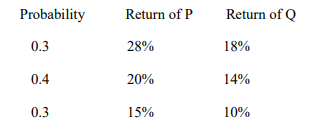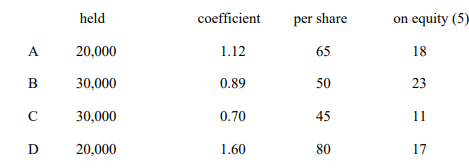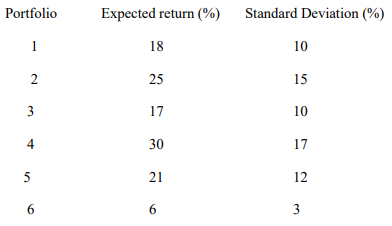
UNIVERSITY EXAMINATIONS: 2018/2019
EXAMINATION FOR THE DEGREE OF BACHELOR OF BUSINESS
INFORMATION TECHNOLOGY
BUSS306 EVALUATION OF BUSINESS INVESTMENTS
FULL TIME/PART TIME/DISTANCE LEARNING
DATE: DECEMBER, 2018 TIME: 2 HOURS
INSTRUCTIONS: Answer Question One & ANY OTHER TWO questions.
QUESTION ONE
a) Consider the following two securities P and Q with the following characteristics:

Assume that an investor owns 60% of security P and 40% of Security Q.
Required:
i. Determine the covariance between security P and Q. (4 Marks)
ii. Determine the correlation coefficient of P and Q. (4 Marks)
iii. Determine the expected return of the portfolio. (2 Marks)
iv. Determine the percentage risk diversification. (4 Marks)
b) Explain any 5 conceptual differences between the arbitrage pricing theory and capital asset pricing
model. (10 Marks)
c) Discuss Three (3) limitations of capital Asset Pricing Model (6 Marks)
QUESTION TWO
a) James is currently holding a portfolio consisting of shares of companies quoted on the Nairobi
Securities exchange as follows:
Company Number of shares Beta-equity Market price Expected return
held coefficient per share on equity (5)

The current market return is 14% per annum and the treasury bills yield is 9% p.a.
Required:
i. Calculate the risk of James’ portfolio relative to that of the market. (6 Marks)
ii. Explain whether or not James should change the composition of his portfolio. (8 Marks)
b) Using a well labeled diagram differentiate between efficient and optimal portfolio. Your diagram
should be supported by the necessary explanations
(6 Marks)
QUESTION THREE
a) Explain the benefits of merger and acquisition. (10 Marks)
b) Explain the main defensive tactics that a company defends itself from hostile takeover.
(10 Marks)
QUESTION FOUR
a) Explain the term market efficiency (1 marks)
b) Identify and explain the three forms of market efficiency (9 Marks)
c) Differentiate between portfolio theory and Arbitrage Pricing Theory (APT) (10 marks)
QUESTION FIVE
An investor is evaluating the portfolios shown below
Portfolio Expected return (%) Standard Deviation (%)

The expected return on the market portfolio is 10% with a variance of 16%. The risk free of interest rates
is 6%.
Required:
i) Using the CML, advice the investor on which of the above portfolios are efficient or inefficient
(12 Marks)
ii) In the case of any inefficient portfolio (s) above, state what the standard deviation should be for
efficiency to be achieved the above expected returns on the respective portfolio (s)
(4 Marks)
iii) Differentiate between Security Market Line (SML) and the Capital Market Line (CML)
(4 Marks)